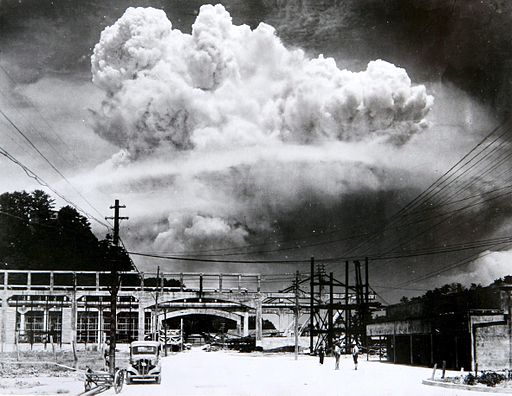Learn It
In middle school, you studied many historical events and developments. You learned that the domestication of plants and animals led to the development of villages, and that the dropping of the atomic bomb resulted in the surrender of Japan in World War II. These events have a cause-and effect-relationship. But there were other events that you studied that did not have a cause-and-effect relationship. In ancient Egypt, the Egyptians developed irrigation, but this did not cause the building of the pyramids or the development of hieroglyphics. These events simply preceded one another. The dropping of the atomic bomb on Japan did not cause the development of the Marshall Plan, an economic plan to rebuild Europe after World War II. One event simply preceded the other.

The dropping of the atomic bomb resulted in the surrender of Japan in World War II. This image shows the atomic cloud over the city of Nagasaki on August 09, 1945, following the bombing of the city in World War II.
Image credit: Hiromichi Matsuda via Wikimedia Commons Opens a new window
In your modern world history class, you study events that were not part of the middle school social studies curriculum. For these topics, you probably do not have enough prior knowledge to determine the relationship between a series of events. One strategy to assist you in determining the relationship between events is to examine the text structure used by the author. Another strategy is to analyze events in chronological order and ask yourself “how” and “why” the events occurred, and did one event cause the other to happen? Placing the events described in the paragraph in chronological order can assist you in determining the relationship between the events, by asking the questions: “Did the earlier event cause the latter event?” “Is there a logical connection between the events or did they happen independently from one another?”
Take a look at the different types of signal words for cause-and-effect and sequence text structures. Recognizing how these words are used will help you determine the relationships between a series of events. You will also examine the events in chronological order and analyze their relationship.
| Text structure | Description | Signal words |
|---|---|---|
| Cause and Effect | Cause-and-effect words signal that one thing causes another thing to happen. Sometimes a cause-and-effect relationship is shown within a sentence that contains these kind of signals. | because causes effects for this reason leads produces in order to so since when whenever consequently therefore if ... then thus as a result therefore from ... to until |
| Sequence | Sequence words tell the order of events and are useful when there is a reference to time in the passage. It can help you place events in chronological order so you can analyze the possible relationship between events.
Once the events are in chronological order, you can use reasoned judgment to determine if they are interrelated or not. |
first second next on (date) initially finally not long after now following preceding before after when at last started, began |
| Combination of Text Structures | As a reader, you need to keep in mind that an author may combine different types of text structures in a document. A sequence passage may end with cause-and-effect sentences to explain that the combination of events caused another event to happen, rather than just one of them causing the event to occur. | Look for both cause-and-effect and sequence signal words. |
Download the Text Structures and Signal Words PDF for a printed version of the different types of text structures and signal words associated with each type. Keep the PDF handy as you progress through the activities in the module.
Let’s apply what you have learned about the use of text structure signal words to help determine the relationship between a series of events described in a document.
Read the following passage.
The 18th century can be categorized as a “revolutionary time.” Political revolutions had brought new governments to the United States, France and parts of Latin America. At the same time, a different type of revolution took place in Great Britain. The first type of revolution to take place was in agriculture. Wealthy landowners began buying up much of the land that village farmers once worked. They enclosed their land with fences or hedges. With larger land holdings, they could cultivate more land. The large landowners also experimented with new agricultural methods such as the seed drill and crop rotation. These new farming methods caused large increases in agricultural production.
Increased food supplies due to the agricultural revolution and better living conditions resulted in population growth. This increased population created a demand for more food and goods, such as cloth. Because of the enclosure movement, many farmers had lost their land and moved to the cities to become factory workers.
Watch the following video to see how signal words are applied to determine the relationship between the events described in the passage.
On the next page, you will explore the chronological order of events from the passage.


